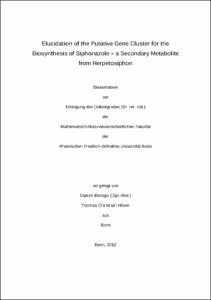Elucidation of the Putative Gene Cluster for the Biosynthesis of Siphonazole – a Secondary Metabolite from Herpetosiphon

Elucidation of the Putative Gene Cluster for the Biosynthesis of Siphonazole – a Secondary Metabolite from Herpetosiphon

| dc.contributor.advisor | König, Gabriele M. | |
| dc.contributor.author | Höver, Thomas Christian | |
| dc.date.accessioned | 2020-04-18T00:04:45Z | |
| dc.date.available | 2020-04-18T00:04:45Z | |
| dc.date.issued | 26.07.2012 | |
| dc.identifier.uri | https://hdl.handle.net/20.500.11811/5351 | |
| dc.description.abstract | Polyketides (PKs) and non-ribosomal peptides (NRPs) are two major classes of natural products. They comprise a vast variety of structurally and functionally diverse compounds, which include a great number of clinically important substances. These metabolites are the product of giant multienzymes termed polyketide synthases (PKSs) and non-ribosomal peptide synthetases (NRPSs), respectively. The present study investigated the putative biosynthetic gene cluster of siphonazole. This compound is produced by the Herpetosiphon strain 060, which belongs to the deep rooted phylum of Chloroflexi, and is the first secondary metabolite described from this group. Siphonazole is composed of building blocks derived from acetate, amino acid and shikimate pathways. The gross structure comprises a styrene moiety, two oxazole rings connected by a C2-bridge and an unusual diene side chain. Genomic DNA of Herpetosiphon sp. 060 was subjected to 454 sequencing yielding draft genomic data of the strain. The application of bioinformatics and molecular biological techniques led to the identification of a hybrid NRPS/PKS gene cluster with ten open reading frames (sphA – sphJ), which encode the putative enzymes for the biosynthesis of siphonazole. Through a detailed bioinformatic analysis, it was revealed that the encoded proteins include eight PKS modules, which are assumably all loaded in trans by the acyltransferase (AT) SphA, and four NRPS modules. The AT has a predicted specificity for malonyl-CoA. Two of the NRPS units are heterocyclisation modules, which are responsible for the formation of the oxazole rings from threonine moieties. The first NRPS module initiates the biosynthesis probably by incorporation of a dihydroxybenzoic acid. In vitro studies with purified protein showed that the potential precursor molecule protocatechuic acid is readily methylated by the O-methyltransferase SphB. The analysis of total mRNA from Herpetosiphon by RT-PCR revealed that sphA – sphJ are only expressed in the first three days of cultivation. In agreement with this early gene expression, the application of imaging mass spectrometry showed that siphonazole is located exclusively at the edge of a growing colony. On the basis of the obtained sequence information, cluster fragments of three overlapping fosmids from a genomic library were successfully recombined by λ-Red recombination methods. Thus, a fosmid construct of 71 kb was generated harbouring genes sphA – sphJ. | en |
| dc.language.iso | eng | |
| dc.rights | In Copyright | |
| dc.rights.uri | http://rightsstatements.org/vocab/InC/1.0/ | |
| dc.subject | Polyketidsynthase | |
| dc.subject | Nichtribosomale Peptidsynthetase | |
| dc.subject | Naturstoff | |
| dc.subject | Biosynthese | |
| dc.subject | genetische Rekombination | |
| dc.subject | Bioinformatik | |
| dc.subject | Chloroflexi | |
| dc.subject | PKS | |
| dc.subject | NRPS | |
| dc.subject | genomic mining | |
| dc.subject | trans-AT | |
| dc.subject.ddc | 570 Biowissenschaften, Biologie | |
| dc.title | Elucidation of the Putative Gene Cluster for the Biosynthesis of Siphonazole – a Secondary Metabolite from Herpetosiphon | |
| dc.type | Dissertation oder Habilitation | |
| dc.publisher.name | Universitäts- und Landesbibliothek Bonn | |
| dc.publisher.location | Bonn | |
| dc.rights.accessRights | openAccess | |
| dc.identifier.urn | https://nbn-resolving.org/urn:nbn:de:hbz:5n-29284 | |
| ulbbn.pubtype | Erstveröffentlichung | |
| ulbbnediss.affiliation.name | Rheinische Friedrich-Wilhelms-Universität Bonn | |
| ulbbnediss.affiliation.location | Bonn | |
| ulbbnediss.thesis.level | Dissertation | |
| ulbbnediss.dissID | 2928 | |
| ulbbnediss.date.accepted | 11.07.2012 | |
| ulbbnediss.fakultaet | Mathematisch-Naturwissenschaftliche Fakultät | |
| dc.contributor.coReferee | Knöss, Werner |
Dateien zu dieser Ressource
Das Dokument erscheint in:
-
E-Dissertationen (4387)




